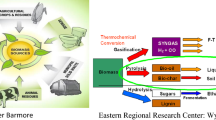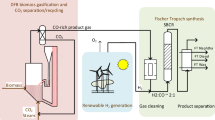Abstract
The results of thermodynamic calculations and experimental data on conversion of wood gasification tars in pyrolysis gas to tar-free fuel gas by partial oxidation with air are reported. The rate of oxygen feeding into the converter, expressed via oxygen excess J, was used as the main controlling parameter of the conversion. The calculation shows that, under the optimum conversion conditions (J = 0.45), the tars are converted virtually completely to gaseous products that are not inferior to the starting substances in the heat of combustion and have approximately 3 times larger volume. In the experiments, because of the effect of lateral heat loss, at the air feeding rate corresponding to J = 0.45–0.50, the temperature is approximately 400°С lower; therefore, the tar conversion reached only 80%. The heat of combustion of the gaseous products after the conversion was 20–30% lower than that of the initial gaseous gasification products, and the volume of the gaseous conversion products increased by a factor of 2.5–3.





Similar content being viewed by others
REFERENCES
Richardson, Y., Blin, J., and Julbe, A., Prog. Energy Combust. Sci., 2012, vol. 38, no. 6, pp. 765–781. https://doi.org/10.1016/j.pecs.2011.12.001
Shen, Y. and Yoshikawa, K., Renew. Sustain. Energy Rev., 2013, vol. 21, pp. 371–392. https://doi.org/10.1016/j.rser.2012.12.062
Asadullah, M., Renew. Sustain. Energy Rev., 2014, vol. 40, pp. 118–132. https://doi.org/10.1016/j.rser.2014.07.132
Donskoi, I.G., Russ. J. Appl. Chem., 2020, vol. 93, no. 4, pp. 519–526. https://doi.org/10.1134/S1070427220040060
Pérez, J.F., Melgar, A., and Benjumea, P.N., Fuel, 2012, vol. 96, no. 6, pp. 487–496. https://doi.org/10.1016/j.fuel.2012.01.064
Rios, M.L.V., González, A.M., Lora, E.E.S., and del Olmo, O.A.A., Biomass Bioenergy, 2018, vol. 108, no. 1, pp. 345–370. https://doi.org/10.1016/j.biombioe.2017.12.002
Heidenreich, S. and Foscolo, P.U., Prog. Energy Combust. Sci., 2015, vol. 46, pp. 72–95. https://doi.org/10.1016/j.pecs.2014.06.002
Hasler, P.H. and Nussbaumer, T., Biomass Bioenergy, 1999, vol. 16, no. 6, pp. 385–395. https://doi.org/10.1016/S0961-9534(99)00018-5
Kislov, V.M., Zholudev, A.F., Kislov, M.B., and Salgansky, E.A., Russ. J. Appl. Chem., 2019, vol. 92, no. 1, pp. 57–63. https://doi.org/10.1134/S1070427219010087
Vershinina, K., Shlegel, N., and Strizhak, P., Combust. Sci. Technol., 2019. https://doi.org/10.1080/00102202.2019.1684908
de Sales, C., Ap, V.B., Maya, D.M.Y., Lora, E.E.S., Jaén, R .L., Reyes, A.M.M., González, A.M., Andrade, R.V., and Martínez, J.D., Energy Convers. Manag., 2017, vol. 145, pp. 314–323. https://doi.org/10.1016/j.enconman.2017.04.101
Su, Y., Luo, Y., Chen, Y., Wu, W., and Zhang, Y., Fuel Process. Technol., 2011, vol. 92, no. 8, pp. 1513–1524. https://doi.org/10.1016/j.fuproc.2011.03.013
Wu, W.G., Luo, Y.H., Chen, Y., Su, Y., Zhang, Y.L., Zhao, S.H., and Wang, Y., Energy Fuels, 2011, vol. 25, no. 6, pp. 2721–2729. https://doi.org/10.1002/ente.201500159
Glazov, S.V., Kislov, V.M., Razmyslov, A.V., and Salganskaya, M.V., Russ. J. Appl. Chem., 2019, vol. 92, no. 7, pp. 1020–1029. https://doi.org/10.1134/S107042721907019X
Salgansky, E.A., Kislov, V.M., Glazov, S.V., and Salganskaya, M.V., J. Combust., 2016, vol. 2016, ID 9637082. https://doi.org/10.1155/2016/9637082
Glazov, S.V., Theor. Found. Chem. Eng., 2019, vol. 53, no. 3, pp. 378–388. https://doi.org/10.1134/S0040579519020052
ACKNOWLEDGMENTS
The elemental composition of pyrolysis tar was determined at the Analytical Center of Shared Use, Institute of Problems of Chemical Physics, Russian Academy of Sciences by Senior Engineer G.V. Guseva.
Funding
The study was financially supported by government assignment no. 0089-2019-0018, state registry no. АААА-А19-119-022690098-3.
Author information
Authors and Affiliations
Corresponding author
Ethics declarations
The authors declare that they have no conflict of interest.
Additional information
Translated from Zhurnal Prikladnoi Khimii, No. 3, pp. 363–370, January, 2021 https://doi.org/10.31857/S0044461821030117
Rights and permissions
About this article
Cite this article
Kislov, V.M., Glazov, S.V., Salganskaya, M.V. et al. Oxidative Conversion of Wood Gasification Products in a Mixing Reactor. Russ J Appl Chem 94, 347–353 (2021). https://doi.org/10.1134/S1070427221030113
Received:
Revised:
Accepted:
Published:
Issue Date:
DOI: https://doi.org/10.1134/S1070427221030113




